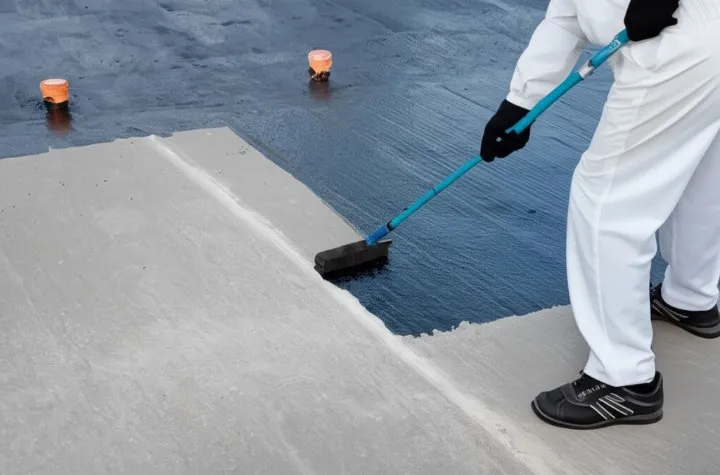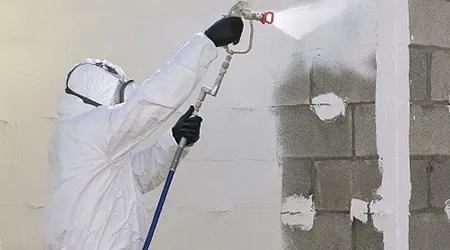
Fluid applied vapor barriers prevent moisture damage in buildings by forming a seamless, monolithic membrane over structural surfaces. Applied as a liquid and cured in place, these barriers block the migration of water vapor into walls, ceilings, and floor assemblies. Unlike sheet-applied barriers that rely on seams and fasteners, fluid systems eliminate weak points where moisture can infiltrate.
These systems are especially valuable in environments with fluctuating humidity levels or in structures where moisture-sensitive materials are used. Their versatility across substrates—concrete, masonry, wood, or gypsum sheathing—makes them ideal for both new construction and retrofit projects. This guide explains how fluid applied vapor barriers work, compares available options, and outlines critical selection criteria for decision-makers.
Key Benefits of Fluid Applied Vapor Barriers
Fluid applied vapor barriers are increasingly preferred due to their strong performance across a range of environmental conditions. They reduce risks associated with moisture intrusion—such as mold, corrosion, and insulation failure—by providing a unified, flexible layer over irregular surfaces.
Comparison Table: Fluid Applied vs. Sheet-Applied Vapor Barriers
| Feature | Fluid Applied Vapor Barriers | Sheet-Applied Vapor Barriers |
| Seamless Coverage | Yes (monolithic) | No (prone to laps and gaps) |
| Installation Complexity | Moderate (requires spray/roller tools) | High (requires cutting, taping seams) |
| Adherence to Substrates | Excellent (bonds to irregular surfaces) | Limited (struggles with uneven areas) |
| Typical Dry Time | 24–48 hours | Not applicable (mechanically fastened) |
| Air Barrier Compatibility | Commonly integrated | Separate product usually needed |
| Resistance to Weather Exposure | High (once cured) | Moderate (depends on sheet type) |
Bonus Tip: In windy or high-rise installations, fluid-applied barriers offer a faster and more secure option than sheets, which are vulnerable to detachment during placement.
Technical Performance Data
Fluid applied vapor barriers must meet stringent performance criteria to function effectively. These metrics are standardized under ASTM and other building code protocols.
Technical Specifications Table
| Specification | Typical Value Range | Importance |
| Water Vapor Transmission (ASTM E96) | ≤ 0.1 perms (Class I vapor barrier) | Prevents vapor diffusion into assemblies |
| Elongation (%) | 200–600% | Flexibility to accommodate movement |
| Application Thickness (Wet Mil) | 40–100 mils | Ensures consistent barrier formation |
| Cure Time (at 70°F/50% RH) | 24–48 hours | Influences construction timelines |
| Service Temperature Range | -40°F to 180°F | Suitability across climate zones |
| UV Resistance | Moderate to High | Depends on product; affects exposed use |
How Fluid Applied Vapor Barriers Work
Fluid applied vapor barriers are polymer-based formulations, typically made of silyl-terminated polyether, acrylics, or bituminous materials. When sprayed or rolled onto a substrate, the material fills surface voids, cures uniformly, and forms an elastomeric film.
Moisture Protection Mechanism
- Vapor Retardation: These barriers limit the diffusion of moisture through porous materials such as concrete or gypsum.
- Air Infiltration Control: Many formulations double as air barriers, reducing energy loss and condensation risks.
- Seam Elimination: Their continuous application avoids leakage points common in mechanically fastened sheet systems.
Over time, this membrane resists UV degradation, minor substrate shifts, and thermal cycling, making it a long-term solution for building envelope integrity.
Things to Consider Before Making a Decision
Choosing the right vapor barrier involves more than selecting a product. It requires careful assessment of environmental, structural, and regulatory conditions.
1. Climate Zone
- In humid climates, vapor barriers should prevent inward vapor drive.
- In cold climates, placement on the interior side may be necessary to avoid condensation within wall cavities.
2. Building Use and Envelope Design
- Facilities like data centers or food storage warehouses have tighter moisture tolerance and demand stronger vapor control.
- Consider the entire wall assembly, including insulation type and location, to avoid trapping moisture between impermeable layers.
3. Material Compatibility
- Check the substrate’s porosity, pH, and moisture level.
- Incompatible substrates can lead to poor adhesion and barrier failure.
4. Code Compliance
- Verify if local codes require a Class I vapor retarder (≤ 0.1 perms) or Class II (0.1–1.0 perms).
- Energy codes may also require continuous air barriers—select products that satisfy both roles when applicable.
Bonus Tip: Conduct a small-area adhesion test to confirm bonding before full-scale application.
Application Process
Surface Preparation
- Clean surfaces of dust, oils, form release agents, or efflorescence.
- Patch large cracks or fill holes before application.
Application Techniques
- Spray: Offers the fastest application for large areas.
- Roller/Brush: Better suited for tight spaces or small projects.
- Use wet-mil gauges to verify correct thickness during installation.
Curing and Protection
- Allow full cure before applying finishes.
- Avoid foot traffic or exterior finishes until barrier is dry.
Bonus Tip: Use temporary protective sheeting if rain is forecasted before the barrier cures.
Industry Trends and Market Insights
Fluid applied barrier systems have seen significant growth due to energy efficiency regulations and improved product chemistry. According to the International Building Performance Data Report 2024, over 68% of commercial buildings constructed in North America last year used fluid applied moisture barriers for external envelope protection.
Demand is expected to grow further with stricter energy codes like ASHRAE 90.1 and the International Energy Conservation Code (IECC), which emphasize continuous air and vapor control.
Common Questions
Are all fluid applied barriers also air barriers?
Not always. While many products offer dual functionality, confirm this in the manufacturer’s technical data sheet (TDS).
Can fluid barriers be used over wet concrete?
Most require dry surfaces. Moisture-tolerant versions exist, but always verify substrate moisture content before application.
How do I measure vapor permeability?
Permeability is measured in perms using ASTM E96. A lower number indicates better vapor resistance.
Can these be used behind cladding systems?
Yes. Once cured, they can safely remain behind rainscreens, stucco, or siding, assuming UV exposure is not prolonged.
Are they more expensive?
Initial material cost may be higher than sheet products, but reduced labor and superior performance often offset this.
Topic FAQ
What is the main purpose of a fluid applied vapor barrier?
To block moisture vapor from entering building assemblies, thus preventing mold, corrosion, and structural degradation.
How does it differ from a liquid waterproofing membrane?
While both are fluid-applied, vapor barriers are specifically rated to restrict water vapor—not just liquid water.
How thick should the application be?
Typically between 40–100 mils wet, depending on product specifications and environmental conditions.
Is reapplication needed over time?
If undamaged, reapplication is rarely required. Periodic inspections ensure ongoing performance.
Can I paint over a cured vapor barrier?
Yes, most products allow paint or coatings once fully cured. Ensure compatibility beforehand.
Make the Right Decision
Fluid applied vapor barriers offer unmatched continuity, adhesion, and adaptability. By forming a seamless shield against water vapor, they safeguard buildings from moisture-related damage and prolong the life of interior finishes and structural elements.
When choosing a barrier system, evaluate the environmental load, material compatibility, and local building codes. Professional spray foam insulation services ensure that the selected system performs effectively for decades, protecting both the building and its occupants.
Reviewer:
Emily Martinez has 12 years of experience in spray foam insulation. She reviewed this article and suggested ways to make the content more useful for contractors looking to grow their customer base.
